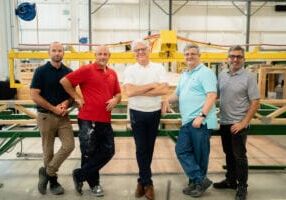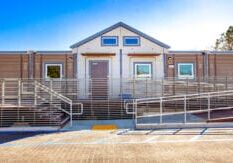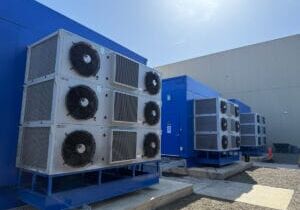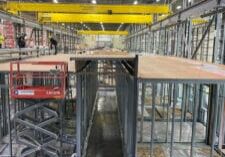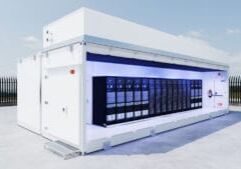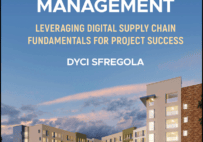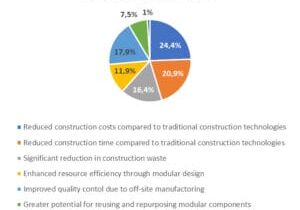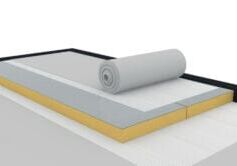Navigating Insurance Challenges in the Modular Construction Industry

Daniel Seltzer, CPCU, is Senior Risk Advisor at RCM&D.
Despite three recent reports from McKinsey & Company (May 2023), Fortune Business Insights (July 2023), and Gitnux (April 2024) highlighting substantial benefits of permanent modular construction—such as 20-50% less time and 15-25% less cost—North American demand for permanent modular construction surprisingly lags behind. With only 4% of total housing starts in the United States, compared to 15% in Japan, and 45% in Scandinavian countries, one can’t help but wonder—why the stark difference? Is culture a determining factor?
My professional career started with a unique training program in 1981 with a global insurer working on Wall Street and Boston, followed by a year of “running slips” on the floor of Lloyd’s of London. Since 1985, I have been a fiercely independent insurance advisor/broker in the industry. After 43 years in this business, I am having fun with “modular” risk since most brokers fail to identify the unique risks inherent within the industry, and insurance companies have yet to promulgate reliable loss statistics for this evolving marketplace. Most price insurance for “Manufacturing” or “Home Builder” risk, where the result can create serious coverage gaps, fine-print exclusionary wording, and insurance policies which do not align with the actual plant then transit then site exposures.
From a risk management and insurance perspective, I have reviewed the property and casualty insurance policies for members of the Modular Building Institute (MBI). Almost without exception, coverage concerns were identified, and in most cases, gaps in coverage were present, including exclusionary wording found within the fine-print of the nearly 100-page policies.
Usually, the insurance broker is at fault, or maybe the insurance carrier added an incorrect form to the policy, and sometimes, the “modular” professional does not invest adequate time in the design and implementation of their insurance program. In this article, I offer only a few observations for the purpose of helping the modular building entrepreneur to become a more complete purchaser of commercial insurance, with the goal being to protect the business and family lifestyle.
1. “Use & Occupancy” (aka Business Interruption) Coverage
To assure you consider the correct type of Business Insurance and amount of protection, a few things must exist. Your insurance broker must be an expert on the subject, and the modular operator must feel comfortable answering their questions.
The following questions are on-point, for example:
- If your plant was destroyed, would you rebuild, and if applicable, would you want rental payments to continue for your family? Of if you lease, do your lease obligations abate?
- How quickly would you need to be back in business? And why?
- If your plant was in pre-loss condition in nine months, would your clients return?
- While down, how much money would you need to maintain revenues, and how would you deploy such funds if they were made available?
- Can we invest time together to lay out a plan?
- Whatever functions were interrupted, could you source these steps to another company or a competitor? At what additional costs?
- Should we consider formulating a reciprocity agreement with another operator?
If your broker has not asked you these questions, please find another broker.
2. Errors & Omissions (aka Professional Liability Insurance)
Attending the WOM Convention and during almost every break-out session at the Offsite Construction Summits, I hear about engineering, approvals, codes, and how essential the planning process is to a successful project. This points directly to the importance of well-crafted contracts, working with experienced pros, considering Errors & Omissions (E&O) and understanding its potential benefits and limitations. “Per Project” insurance was affordable and readily available in the old days, but for the last several years, “Practice” policies are the norm. There are two facts you must be familiar; first, the engineer’s, architect’s or other design-build consultants policy limits apply to all their customers and are NOT only for your contract, and second, in 90% of the cases, these same limits extend back into time to the date of the first time they purchased E&O insurance. This is known as the “retroactive date.”
For illustrative purposes, your agreement with Y3TmX Engineering, Inc. requires maintaining $1,000,000 Professional Liability, and they present a certificate of insurance (COI). The $1,000,000 per accident or Wrongful Act limit is available to all current clients and all prior projects, completed or on-going. If they show a retroactive date of June 15, 2007, this same $1,000,000 is available for all projects Y3TmX Engineering was/is engaged reaching back over 15 years.
If your broker has not discussed this with you, or if they have yet to propose viable risk management techniques to protect your balance sheet, please carefully choose another broker.
3. Incorrect General Liability Classification
With over 325 business types to choose from, underwriters price General Liability, including Products Liability, utilizing rates (pure loss rate + other charges) promulgated by their actuaries and third-party advisory services (mostly ISO) given historic loss levels as a percentage of sales, payroll, or area.
Since the permanent modular construction industry is a relative newcomer to this country, and the multitude of industries being built to support the sector are so varied, the General & Excess Liability insurance policies crafted by over 750 insurers, I strongly suggest your policy be evaluated by an expert. What you do not want is a contract to an argument. Post-loss or after litigation commences, is not the time to learn about coverage deficiencies. Although not an adversary, the insurance carrier wrote the insurance policy (contract) language, and they did so with their interests being number one. The playing field should be tilted in your favor as much as possible pre-loss.
Prior to becoming a client, one such modular operator was previously insured by a carrier who was only aware of their manufacturing, and not their contracting operations. The coverage was limited to their single plant location, and losses arising from transit or contracting activities were specifically excluded.
Are you certain your coverage does not contain warranties, restrictions, or limitations with which you are not familiar?
4. Possession or Bill of Lading
The “simple solution” I reference is not complex like high school organic chemistry or collegiate-level calculus, but it does require thought, experience, and a deep understanding. Knowledge surrounding frequency, values, conveyance types, purchase orders, and precedence. Insurance carriers are accustomed to insuring raw materials, finished stock, and goods in transit, or materials located in a temporary warehouse or a manufacturing plant. It is to the advantage of the insurance company to charge premium and then exclude or limit their exposure when possible.
Just because your incoming Bill of Lading indicates FOB Destination (your plant), and your outgoing Bill of Lading is FOB Shipping Point (your plant), does not mean you are protected. For example, the on-site general contractor calls asking about the status of your $173,000 shipment. You are shocked since it was released last Monday. The shipper indicates a problem came up, and the shipment is missing or damaged. Your BOL releases you from liability, but your client (project owner) is not happy, and the general contractor is now going to deliver three weeks late.
Negotiate property coverage to extend to your interests, and that of your customers, if there is no other valid and collectible insurance? If this is not in place for your company currently, we can help.
5. Risk Transfer
a term used frequently by licensed insurance brokers, many of whom do not support their clients’ needs A through Z. What do I mean by “Risk Transfer?” The party holding themselves out as a professional and being paid to perform specific tasks should be responsible for assuming risk and pre-funding exposure to loss created by or arising from their actions, omissions or services. For true risk transfer to take place, applicable contracts must be studied and coordination with counsel must occur. Unless licensed to provide legal guidance, the insurance broker should not supply final indemnification language without being clear of the need for legal counsel approval.
95% of insurance brokers I speak with are not up to speed on the subject of Additional Insured. In 1985 and again in 2013, substantial changes were made by the insurance industry. Utilizing antiquated contract language (purchase orders, leases, partnership agreements, loan covenants, etc.) will not accomplish risk transfer. Note, the benefits of being an Additional Insured are not realized by simply receiving a certificate of insurance which states you are Additional Insured.
The solution – utilizing practical written minimum insurance and indemnity requirements, along with monitoring certificates of insurance by someone who has COI training will not yield a perfect risk transfer strategy, but the exposure will be managed much better than it is currently.
More from Modular Advantage
Resia: Breaking All the Rules
Resia Manufacturing, a division of U.S.-based Resia, is now offering prefabricated bathroom and kitchen components to industry partners. Its hybrid fabrication facility produces more precise bathroom and kitchen components (modules) faster and at lower cost than traditional construction. Here’s how Resia Manufacturing does it.
How LINQ Modular Innovates to Bring Modular To The Market in the UAE and Beyond
LINQ Modular, with an office and three manufacturing facilities in Dubai, is a modular firm based in United Arab Emirates. The company is on a mission: to break open the housing and construction markets in the Gulf Cooperation Council (GCC) area with modular.
ModMax: Redefining Modular Construction with Confidence and Precision
ModMax was born out of frustration—frustration with five persistent pain points in modular construction: Permitting bottlenecks. Production delays. Rigid designs. Disconnect between “the office” and the field. Lack of transparency and communication.
LifeArk: Disaster-Resilient Housing from Recycled Plastic and 100-year-old Technology
Wee compares LifeArk’s housing units to Yeti coolers, as they are built similarly. Each component takes 15 to 20 minutes to manufacture, has an R-value of 40, and includes molded slots and chases for wiring, plumbing, fire sprinklers, and other utilities.
Building the Future of Modular Edge Infrastructure
The edge data center market is expanding rapidly, driven by the surge in AI workloads, IoT adoption, and the need for localized compute power. In these environments, sustainability, scalability, and reliability are non-negotiable. Cooling is among the most complex challenges for operators—and one of the most decisive factors in long-term success.
Accelerating Light-Gauge Steel Construction: A Semi-Automated Digital Workflow for Off-Site Projects
For construction professionals, the message is clear. By adopting semi-automation and digitalization, companies can deliver projects faster, more accurately, and more profitably, while also building stronger collaboration across teams. The approach is not about replacing people with machines, but about empowering people with better tools and processes.
Why Modular Data Centers Are Gaining Momentum
Artificial intelligence, high-performance computing, and edge applications push the limits of traditional “stick-built” data centers. They take years build, often struggle with high density workloads, and aren’t optimized for deployments near end users. Modular data center platforms are purpose-built to address these challenges, offering flexibility and scalability to adapt to evolving technologies, while opening new opportunities for the modular construction industry.
Supply Chain Innovation in Action: 5 Habits Every Modular Leader Should Practice
By applying these principles to supply chain practices — collaborative planning, strategic procurement, scenario modeling, digital tools, and transparent forecasting — construction leaders can build value chains that are not just efficient and agile, but truly innovative.
Exploring the Role of Modular Integrated Construction (MiC) in Advancing Circular City Principles – A Survey of Stakeholder Perspectives
The survey findings highlight the significant potential of Modular integrated Construction (MiC) in advancing the development of circular cities. By reducing costs, accelerating construction timelines, and minimizing waste generation, MiC offers a promising approach to sustainable urban development.
The Use of MS POLYMER™-Based Sealants and Adhesives in Modular Building
These products combine flexibility and elastic recovery with excellent adhesion to different substrates and have already shown their usefulness in traditional construction. Now it’s time for them to be put to use in the modular construction industry.



